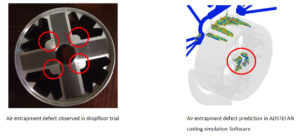Prediction of air entrapment defect in high pressure die casting (HPDC) using computer simulation
Evacuation of air in the die cavity is a critical aspect of die design in HPDC practice. As the melt fills the die cavity, air moves towards regions of last filling. Vents / overflows are provided in such locations. Using computer simulation of high pressure die casting, locations to provision the air vents can be precisely established. Designer can also arrive at size, locations, and number of needed to produce sound casting.
At ProSIM (www.pro-sim.com) we use casting simulation software ADSTEFAN (www.adstefan.com) by Hitachi, for simulation based die design optimization and rapid process development with reduced plant trials. By conducting casting simulation of HPDC back pressure generated in the casting is also quantitatively estimated, and its effect of mold filling simulated.

Figure above (left) shows the air entrapment defect observed in the trial production of a magneto housing. This design had a rejection rate of 42%. Casting simulation was used to simulate the HPDC of the magneto housing. Results of air entrapment (air evacuation during melt flow and die cavity filling) was simulated. Figure (right) shows regions of air entrapment (circled in red). In the figure of simulation result, blue color represents air, grey color (transparent) represents liquid metal other colors represent regions of air+ melt mixture. Such regions as shown in red circle, represent potential hotspots for airentrapments to occur. These regions are surrounded by molten metal, and air has no way to escape. Such situation results in formation of air entrapment defect.By comparing the figures, we can see that the prediction of air entrapment defect is matching quite accurately with the trial production sample.
Once the model is developed and finetuned, the same is used as a workbench to carry out multiple number of die design changes, including air flow, vent designs to optimize the process. Using such simulation based optimization of die design, gating and process design of magneto housing casting was optimized to reduce the rejection rate from 42% to 3%.
For more details on how to use casting simulation to eliminate air entrapment defects contact casting@pro-sim.com
Recent Posts